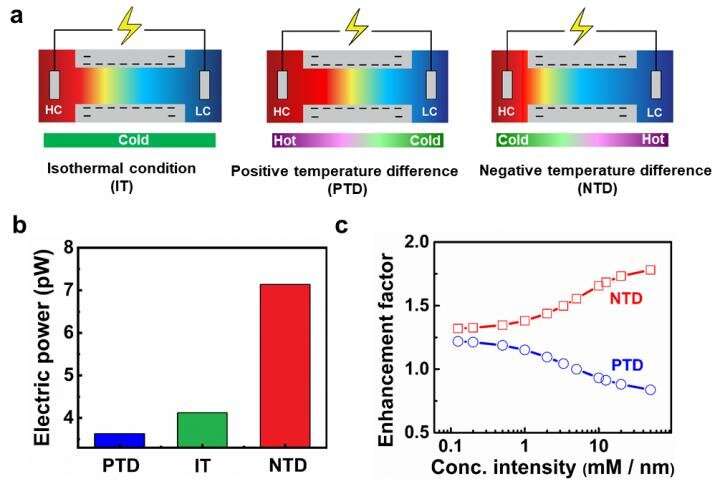(a) Schematic illustration of the ion concentration profiles with asymmetric transmembrane temperature differences. (b) Electric power under different temperature differences. (c) At small transmembrane concentration intensities, both positive and negative temperature differences contribute to the electric power. At high transmembrane concentration intensities, a negative temperature difference promotes the power extraction and a positive temperature difference hinders the electric power. Credit: ©Science China Press
Salinity gradient energy is recognized as a promising candidate for the substitution of traditional fossil fuels. Recently nanofluidic salinity gradient energy harvesting via ion channels or membranes has drawn increasing interest due to the advances in materials science and nanotechnology, which could offer much higher power density than the macro reverse electrodialysis systems, indicating its potential to harvest the blue energy (about 1.4-2.6 TW) released by mixing seawater and river water as well as enhancing the power extracted for membrane-based osmotic heat engines.
Previous efforts focusing on the nanofluidic energy conversion system mainly deal with the isothermal conditions. The conventional viewpoint suggests that improving membrane potential requires a larger temperature and a long channel length to guarantee a large selectivity and a high effective concentration difference. This intuitive judgement accounts for increasing temperature to achieve better performance. However, the transmembrane temperature difference is a very important, yet long-overlooked element that impacts the performance of nanofuidic devices.
In a new research article published in the Beijing-based National Science Review, scientists at Huazhong University of Science and Technology, China present an anomalous temperature dependence in nanofluidic power generation. A negative temperature difference can significantly improve the membrane potential due to the impact of ionic thermal up-diffusion that promotes selectivity and suppresses ion concentration polarization, especially at the low concentration side, which results in dramatically enhanced electric power. Simple and efficient ways are also proposed to fabricate tunable ionic voltage sources and enhance salinity gradient energy conversion based on small nanoscale biochannels and mimetic nanochannels.
"Scientifically, we reveal the importance of a long-overlooked element, transmembrane temperature difference, in nanofluidic salinity gradient energy harvesting," Prof. Wei Liu said, "For applications and guidance, we can fabricate tunable ionic voltage sources, where the voltage is tuned by the temperature at the low concentration side and the internal resistance adjusted by the temperature at the high concentration side. And waste heat can be employed to enhance the power output and ionic flux by establishing transmembrane temperature difference to match the optimal transmembrane concentration intensity under the nanoscale biochannels and mimetic nanochannels."
More information: Rui Long et al, Ionic thermal up-diffusion in nanofluidic salinity gradient energy harvesting, National Science Review (2019). DOI: 10.1093/nsr/nwz106
Provided by Science China Press
























